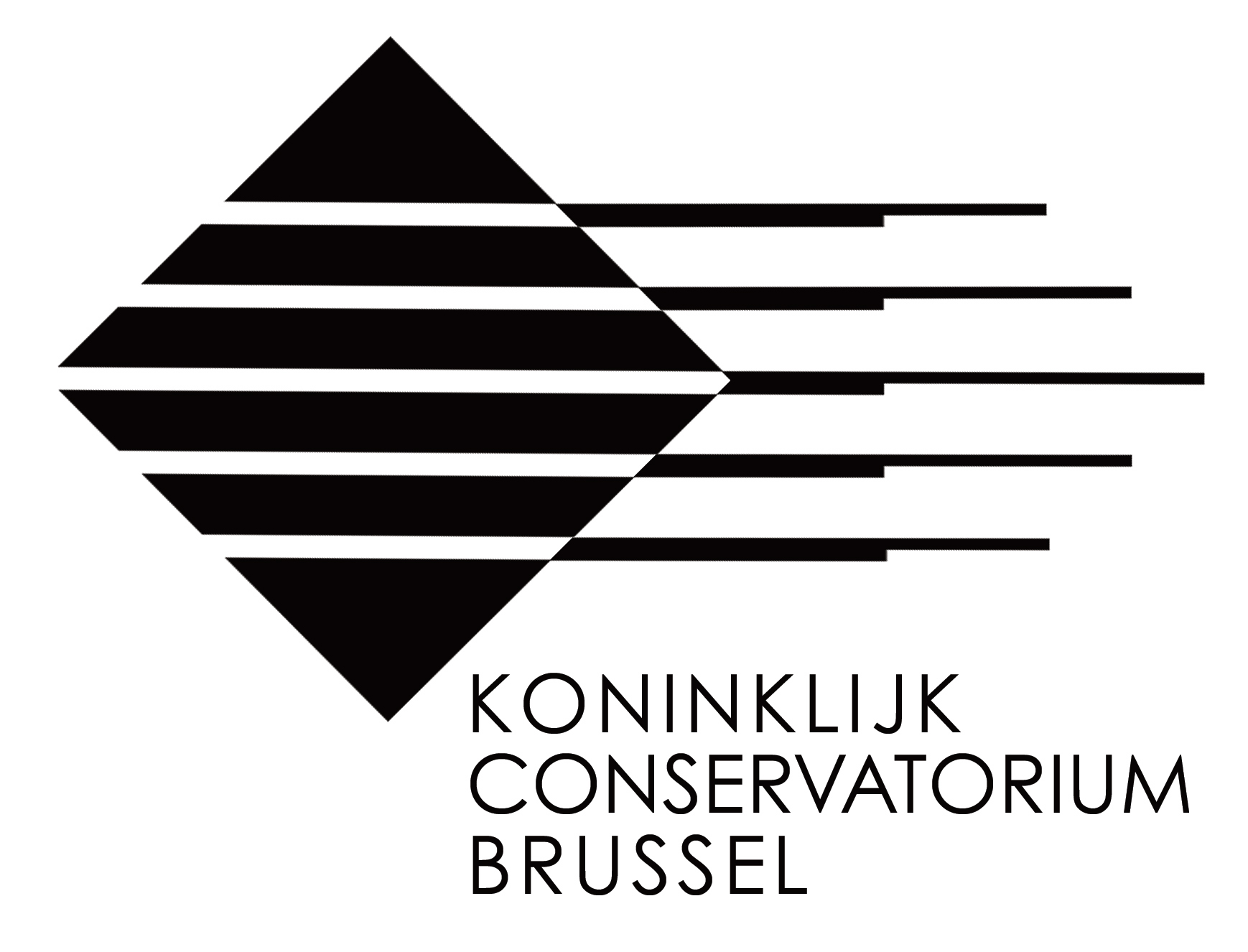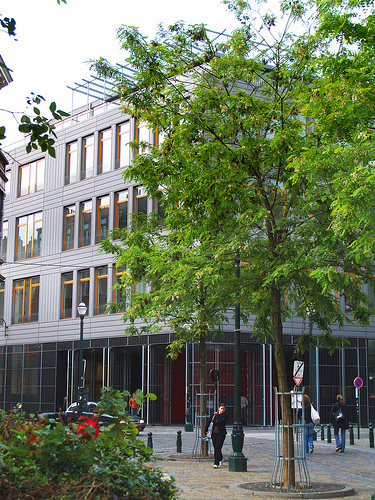|
Brussels Conservatory
The Royal Conservatory of Brussels (french: Conservatoire royal de Bruxelles, nl, Koninklijk Conservatorium Brussel) is a historic conservatory in Brussels, Belgium. Starting its activities in 1813, it received its official name in 1832. Providing performing music and drama courses, the institution became renowned partly because of the international reputation of its successive directors such as François-Joseph Fétis, François-Auguste Gevaert, Edgar Tinel, Joseph Jongen or Marcel Poot, but more because it has been attended by many of the top musicians, actors and artists in Belgium such as Arthur Grumiaux, José Van Dam, Sigiswald Kuijken, Josse De Pauw, Luk van Mello and Luk De Konink. Adolphe Sax, inventor of the saxophone, also studied at the Brussels Conservatory. In 1967, the institution split into two separate entities: the , which teaches in Dutch, and the , which continued teaching in French. While the French-speaking entity remained an independent public institutio ... [...More Info...] [...Related Items...] OR: [Wikipedia] [Google] [Baidu] |
Erasmushogeschool Brussel
The Erasmus Brussels University of Applied Sciences and Arts (Dutch: ''Erasmushogeschool Brussel'') is an institute of higher education based in Brussels, Belgium. Like the EU student exchange programme ERASMUS, EhB is named after the humanistic philosopher and author Desiderius Erasmus, who resided in Anderlecht, a municipality of Brussels. History The Flemish Higher Education Decree of 13 July 1994 ushered in a large-scale merger operation and reorganisation of the educational system (disciplines and curricula). More than 160 institutions were reduced to 22 colleges. Erasmus University College Brussels came into being in 1995 from a merger of some ten colleges in and around Brussels. Department and programmes EhB has around 4500 students and consists of six departments that offer bachelor and master of Art degree programmes in 20 study areas. Departments * Management, Media & Society * Healthcare, Design & Technology * Education * School of Arts: Koninklijk Conservatori ... [...More Info...] [...Related Items...] OR: [Wikipedia] [Google] [Baidu] |
Josse De Pauw
Josse De Pauw (born 15 March 1952) is a versatile Belgian actor, film director, dramatist, author and columnist. He was married to modern dance performer Fumio Ikeda for over thirty years. Theatre After graduating from the Royal Conservatory in Brussels De Pauw founded the mime theatre group Radeis International (1976), and after that Schaamte, the theatre company that would be the start of the Brussels Kaaitheater. He both writes and performs in highly regarded theatre plays such as ''Larf'' and ''Weg'' (both with music by Peter Vermeersch, and has received many awards for his works, such as the Océ Podium Prize for his entire oeuvre in 2000. He has led theatre companies such as Het Net (Bruges), Victoria (Ghent) and Het Toneelhuis (Antwerp). With the latter company, he played the main role in "Tenebrous Heart", after Joseph Conrad's novel, performed in Paris in 2011. Throughout his career he has collaborated with various actors, directors, writers and artists, such as Tom Jans ... [...More Info...] [...Related Items...] OR: [Wikipedia] [Google] [Baidu] |
Charles Van Der Stappen
Charles van der Stappen (also Karl van der Stappen; 19 September 1843 – 21 October 1910), was a Belgian sculptor, born in Saint-Josse-ten-Noode. Life Educated at the Académie Royale des Beaux-Arts in Brussels (1859–1868), van der Stappen's contribution to the Brussels Salon was "The Faun's Toilet" of 1869, and thereafter he began to produce work of a high and novel order in every class of sculpture, and soon, along with Paul de Vigne, became recognized as the leader of the section of the new Belgian school of sculpture which infused models derived from Greek and Roman models and the art of the Italian Renaissance with naturalistic detail and fleeting action. His best-known funeral monuments are those to Alexandre Gendebien (1874) and Baron Coppens, at Sheel (1875). His statues include ''William the Silent,'' set up at the Petit Sablon Square, and two in the Brussels Museum, ''The Man with the Sword,'' and "The Sphinx". The bronze group ''Ompdrailles'' was acquired by th ... [...More Info...] [...Related Items...] OR: [Wikipedia] [Google] [Baidu] |
Prince-Bishopric Of Liège
The Prince-Bishopric of Liège or Principality of Liège was an Hochstift, ecclesiastical principality of the Holy Roman Empire that was situated for the most part in present-day Belgium. It was an Imperial State, Imperial Estate, so the List of bishops and prince-bishops of Liège, bishop of Liège, as its prince, had a seat and a vote in the Imperial Diet (Holy Roman Empire), Imperial Diet. The Prince-Bishopric of Liège should not be confused with the Diocese of Liège, which was larger and over which the prince-bishop exercised only the usual responsibilities of a bishop. The bishops of Liège acquired their status as prince-bishops between 980 and 985 when Bishop Notker of Liège, who had been the bishop since 972, received secular control of the County of Huy from Otto II, Holy Roman Emperor. From 1500, the prince-bishopric belonged to the Lower Rhenish–Westphalian Circle. Its territory included most of the present Belgian provinces of Liège (province), Liège and Limbu ... [...More Info...] [...Related Items...] OR: [Wikipedia] [Google] [Baidu] |
Pediment
Pediments are gables, usually of a triangular shape. Pediments are placed above the horizontal structure of the lintel, or entablature, if supported by columns. Pediments can contain an overdoor and are usually topped by hood moulds. A pediment is sometimes the top element of a portico. For symmetric designs, it provides a center point and is often used to add grandness to entrances. The tympanum, the triangular area within the pediment, is often decorated with a pedimental sculpture which may be freestanding or a relief sculpture. The tympanum may hold an inscription, or in modern times, a clock face. Pediments are found in ancient Greek architecture as early as 600 BC (e.g. the archaic Temple of Artemis). Variations of the pediment occur in later architectural styles such as Classical, Neoclassical and Baroque. Gable roofs were common in ancient Greek temples with a low pitch (angle of 12.5° to 16°). History The pediment is found in classical Greek temples, Et ... [...More Info...] [...Related Items...] OR: [Wikipedia] [Google] [Baidu] |
Musée Du Louvre
The Louvre ( ), or the Louvre Museum ( ), is the world's most-visited museum, and an historic landmark in Paris, France. It is the home of some of the best-known works of art, including the ''Mona Lisa'' and the ''Venus de Milo''. A central landmark of the city, it is located on the Right Bank of the Seine in the city's 1st arrondissement (district or ward). At any given point in time, approximately 38,000 objects from prehistory to the 21st century are being exhibited over an area of 72,735 square meters (782,910 square feet). Attendance in 2021 was 2.8 million due to the COVID-19 pandemic, up five percent from 2020, but far below pre-COVID attendance. Nonetheless, the Louvre still topped the list of most-visited art museums in the world in 2021."The Art Newspaper", 30 March 2021. The museum is housed in the Louvre Palace, originally built in the late 12th to 13th century under Philip II. Remnants of the Medieval Louvre fortress are visible in the basement ... [...More Info...] [...Related Items...] OR: [Wikipedia] [Google] [Baidu] |
Renaissance Revival Architecture
Renaissance Revival architecture (sometimes referred to as "Neo-Renaissance") is a group of 19th century architectural revival styles which were neither Greek Revival nor Gothic Revival but which instead drew inspiration from a wide range of classicizing Italian modes. Under the broad designation Renaissance architecture nineteenth-century architects and critics went beyond the architectural style which began in Florence and Central Italy in the early 15th century as an expression of Renaissance humanism; they also included styles that can be identified as Mannerist or Baroque. Self-applied style designations were rife in the mid- and later nineteenth century: "Neo-Renaissance" might be applied by contemporaries to structures that others called "Italianate", or when many French Baroque features are present (Second Empire). The divergent forms of Renaissance architecture in different parts of Europe, particularly in France and Italy, has added to the difficulty of defining an ... [...More Info...] [...Related Items...] OR: [Wikipedia] [Google] [Baidu] |
Jean-Pierre Cluysenaer
Jean-Pierre Cluysenaar (1811–1880) was a Belgian architect. He is the father of the Cluysenaar family. Family He was born in Kampen in the Netherlands as a son of Joannes Kluysenaar and Garidenia Kluysenaar, a Dutch family of architects and engineers. Jean-Pierre Cluysenaar was the father of the Cluysenaar family. His descendants became famous Belgian painters, sculptors and architects. During the United Kingdom of the Netherlands his family settled in the southern Belgian provinces. Career Cluysenaar studied architecture at the Académie Royale des Beaux-Arts in Brussels under Tilman-François Suys. His teacher influenced him in his preference for the architecture of the Italian Renaissance. Cluysenaer had a talent for business. He took the initiative for some very profitable real estate projects - such as the Galeries Royales Saint-Hubert in Brussels - in which he played the double role of architect and co-financier. He also had a good reputation amongst the Bel ... [...More Info...] [...Related Items...] OR: [Wikipedia] [Google] [Baidu] |
French Language
French ( or ) is a Romance language of the Indo-European family. It descended from the Vulgar Latin of the Roman Empire, as did all Romance languages. French evolved from Gallo-Romance, the Latin spoken in Gaul, and more specifically in Northern Gaul. Its closest relatives are the other langues d'oïl—languages historically spoken in northern France and in southern Belgium, which French ( Francien) largely supplanted. French was also influenced by native Celtic languages of Northern Roman Gaul like Gallia Belgica and by the ( Germanic) Frankish language of the post-Roman Frankish invaders. Today, owing to France's past overseas expansion, there are numerous French-based creole languages, most notably Haitian Creole. A French-speaking person or nation may be referred to as Francophone in both English and French. French is an official language in 29 countries across multiple continents, most of which are members of the ''Organisation internationale de la Francophonie'' ... [...More Info...] [...Related Items...] OR: [Wikipedia] [Google] [Baidu] |
Dutch Language
Dutch ( ) is a West Germanic language spoken by about 25 million people as a first language and 5 million as a second language. It is the third most widely spoken Germanic language, after its close relatives German and English. ''Afrikaans'' is a separate but somewhat mutually intelligible daughter languageAfrikaans is a daughter language of Dutch; see , , , , , . Afrikaans was historically called Cape Dutch; see , , , , , . Afrikaans is rooted in 17th-century dialects of Dutch; see , , , . Afrikaans is variously described as a creole, a partially creolised language, or a deviant variety of Dutch; see . spoken, to some degree, by at least 16 million people, mainly in South Africa and Namibia, evolving from the Cape Dutch dialects of Southern Africa. The dialects used in Belgium (including Flemish) and in Suriname, meanwhile, are all guided by the Dutch Language Union. In Europe, most of the population of the Netherlands (where it is the only official language spoken country ... [...More Info...] [...Related Items...] OR: [Wikipedia] [Google] [Baidu] |






.jpg)